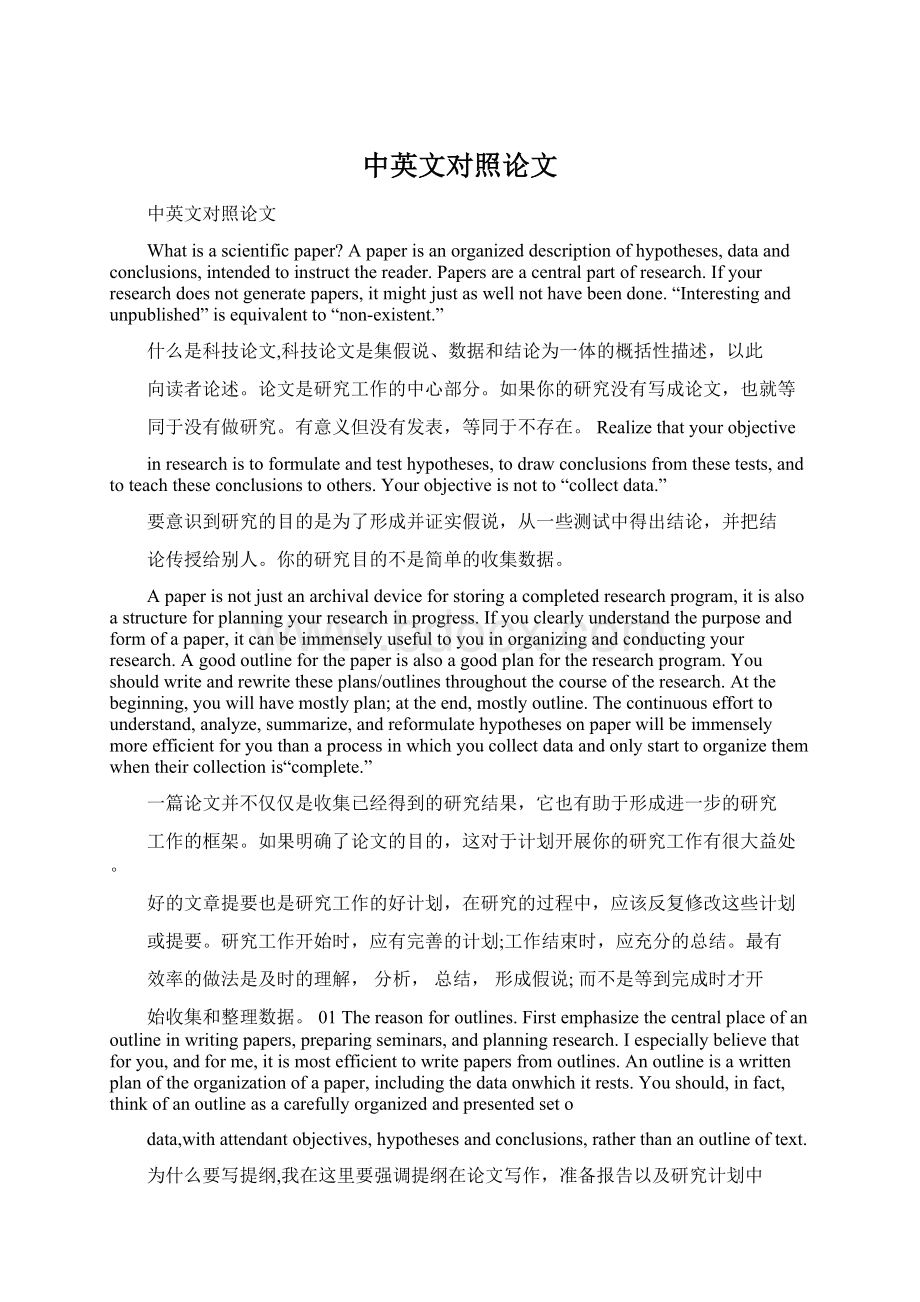中英文对照论文.docx
《中英文对照论文.docx》由会员分享,可在线阅读,更多相关《中英文对照论文.docx(8页珍藏版)》请在冰豆网上搜索。

中英文对照论文
中英文对照论文
Whatisascientificpaper?
Apaperisanorganizeddescriptionofhypotheses,dataandconclusions,intendedtoinstructthereader.Papersareacentralpartofresearch.Ifyourresearchdoesnotgeneratepapers,itmightjustaswellnothavebeendone.“Interestingandunpublished”isequivalentto“non-existent.”
什么是科技论文,科技论文是集假说、数据和结论为一体的概括性描述,以此
向读者论述。
论文是研究工作的中心部分。
如果你的研究没有写成论文,也就等
同于没有做研究。
有意义但没有发表,等同于不存在。
Realizethatyourobjective
inresearchistoformulateandtesthypotheses,todrawconclusionsfromthesetests,andtoteachtheseconclusionstoothers.Yourobjectiveisnotto“collectdata.”
要意识到研究的目的是为了形成并证实假说,从一些测试中得出结论,并把结
论传授给别人。
你的研究目的不是简单的收集数据。
Apaperisnotjustanarchivaldeviceforstoringacompletedresearchprogram,itisalsoastructureforplanningyourresearchinprogress.Ifyouclearlyunderstandthepurposeandformofapaper,itcanbeimmenselyusefultoyouinorganizingandconductingyourresearch.Agoodoutlineforthepaperisalsoagoodplanfortheresearchprogram.Youshouldwriteandrewritetheseplans/outlinesthroughoutthecourseoftheresearch.Atthebeginning,youwillhavemostlyplan;attheend,mostlyoutline.Thecontinuousefforttounderstand,analyze,summarize,andreformulatehypothesesonpaperwillbeimmenselymoreefficientforyouthanaprocessinwhichyoucollectdataandonlystarttoorganizethemwhentheircollectionis“complete.”
一篇论文并不仅仅是收集已经得到的研究结果,它也有助于形成进一步的研究
工作的框架。
如果明确了论文的目的,这对于计划开展你的研究工作有很大益处。
好的文章提要也是研究工作的好计划,在研究的过程中,应该反复修改这些计划
或提要。
研究工作开始时,应有完善的计划;工作结束时,应充分的总结。
最有
效率的做法是及时的理解,分析,总结,形成假说;而不是等到完成时才开
始收集和整理数据。
01Thereasonforoutlines.Firstemphasizethecentralplaceofanoutlineinwritingpapers,preparingseminars,andplanningresearch.Iespeciallybelievethatforyou,andforme,itismostefficienttowritepapersfromoutlines.Anoutlineisawrittenplanoftheorganizationofapaper,includingthedataonwhichitrests.Youshould,infact,thinkofanoutlineasacarefullyorganizedandpresentedseto
data,withattendantobjectives,hypothesesandconclusions,ratherthananoutlineoftext.
为什么要写提纲,我在这里要强调提纲在论文写作,准备报告以及研究计划中
的重要作用。
我尤其相信按照提纲进行写作对我们大家都是最有效的方法。
提纲
是一篇论文的行文计划,应该包括论文所依靠的数据。
事实上,提纲不仅仅是列出各段的内容,而是按照目的,假说,结论来精
心组织数据。
Anoutlineitselfcontainslittletext.IfyouandIcanagreeonthedetailsoftheoutline(thatis,onthedataandorganization),thesupportingtextcanbeassembled
fairlyeasily.Ifwedonotagreeontheoutline,anytextisuseless.Muchofthetimeinwritingapapergoesintothetext;mostofthethoughtgoesintotheorganizationofthedataandintotheanalysis.Itcanberelativelyefficienttogothroughseveral(evenmany)cyclesofanoutlinebeforebeginningtowritetext;writingmanyversionsofthefulltextofapaper
isslow.
提纲本身应该文字简练。
如果大家都同意提纲中的细节部分,那么正文组织起
来就更容易。
在我们就提纲达成一致以前,写正文是没有意义的。
写文章时,
大部份时间花在写正文上;而大部份思考是用在整理和
分析数据。
在动笔前,详细讨论几遍写作提纲会提高写作效率;写很多遍正文
反倒很慢。
AllthewritingthatIdo-papers,reports,proposals(and,ofcourse,slidesforseminars)-Idofrom
outlines.Iurgeyoutolearnhowtousethemaswell.
我写的所有文章,包括论文,报告,建议(当然还有讨论会的胶片)都从提
纲开始。
我也希望你们能学会1
使用它。
Howshouldyouconstructanoutline?
Theclassicalapproachistostartwithablankpieceofpaper,andwritedown,inanyorder,allimportantideasthatoccurtoyouconcerningthepaper.Askyourselftheobviousquestions:
“WhydidIdothiswork?
”“Whatdoesitmean?
”“WhathypothesisdidImeantotest?
”“WhatonesdidIactuallytest?
”“Whatweretheresults?
”“Didtheworkyieldanewmethodorcompound?
What?
”“WhatmeasurementsdidImake?
”“Whatcompounds?
Howwerethey
characterized?
”Sketchpossibleequations,figures,andschemes.Itisessentialtotrytogetthemajorideaswrittendown.Ifyoustarttheresearchtotestonehypothesis,anddecide,whenyouseewhatyouhave,thatthedatareallyseemtotestsomeotherhypothesisbetter,don’tworry.Writethembothdown,andpickthebestcombinationsofhypotheses,objectivesanddata.Oftentheobjectivesofapaperwhenitisfinishedare
differentfromthoseusedtojustifystartingthework.Muchofgoodscienceisopportunisticand
revisionist.
你应该如何起草你的提要,最经典的方法就是找一页空白的纸,以任何顺序,
写下与这篇文章有关的所有重要观点。
自问一些显而易见的问题:
为什么我要做
这项工作,它意味着什么?
我要验证哪些假设?
我究竟验证了哪些假设,结果
如何,这项工作产生了新方法或新物质吗,都是什么,我都做了那些测试,什
么化合物,它们是如何表征的,展示相关的方程,图表和示意图。
试着写出主
要的观点。
如果你的研究开始是为证实一个假设,然而当你发现你有的数据仿佛
真的可以更好地验证其它的假设时,你也不必担心。
把它们两者都写出来,去选
择假设,目的和数据的最佳组合。
时常,当一篇文章完成时,它的目的和开始
时是不同的。
许多好的科学来自机遇和反复修正。
Whenyouhavewrittendownwhatyoucan,startwithanotherpieceofpaperand
trytoorganizethe
jumbleofthefirstone.Sortallofyourideasintothreemajorheaps(A-C).
当你已经写下你能写的,再拿出一页纸,试着草拟一份提纲。
将你的观点分成
三大类(见A,B,C)
A)Introduction
WhydidIdothework?
Whatwerethecentralmotivationsandhypotheses?
A)引言
为什么我要做这件工作,主要的目的和假设是什么,
B)ResultsandDiscussion
Whatweretheresults?
Howwerecompoundsmadeandcharacterized?
Whatwasmeasured?
B)结果和讨论
结果是什么,化合物是怎样合成与表征的,测试方法是什么,
C)Conclusions
Whatdoesitallmean?
Whathypotheseswereprovedordisproved?
WhatdidIlearn?
Whydoesitmake
adifference?
C)结论
所有这一切意味着什么,证实或否定了什么假设,我学到了什么,结果为什
么与众不同,
Next,takeeachofthesesections,andorganizeitonyetfinerscale.Concentrateonorganizingthedata.Constructfigures,tables,andschemestopresentthedataasclearlyandcompactlyaspossible.Thisprocesscanbeslow-Imaysketchafigure5-10timesindifferentways,tryingtodecidehowitismost
clear(andlooksbestaesthetically).
接下来,把每一部分再仔细组织。
尤其是要集中整理数据。
要尽可能把数据
以清晰、紧凑的图表来展示。
这个过程也许会慢些。
我可能要用5~10次,而且
是以不同的方式,来构思一张图,以便决定怎样它才最
清楚(而且看上去更加美观)。
Finally,puteverything—outlineofsections,tables,sketchesoffigures,equations-ingoodorder.最后,2
把所有这些—3
points?
Whatstrategydidweuse?
一般而言,引言应该包含以下几个要素:
工作目的。
对工作目的评价:
该工作为什么很重要,
工作背景:
谁做了什么工作,做得怎么样,以前我们做了哪些工作,
导读:
读者应该注意该文章的哪些方面,有意义的要点有哪些,我们用到了哪
些策略,
Summaryconclusion.Whatshouldthereaderexpectasconclusion?
Inadvanced
versionsoftheoutline,youshouldalsoincludeallthesectionsthatwillgointheExperimentalsection(atthispoint,justasparagraphsubheadings).
总结结论。
读者期望什么样的结论呢,在提纲的前几个版本中,你应该包括实
验部分中涉及到的所有内容。
(在这一点上,就像是段落的副标题)。
ResultsandDiscussion.Theresultsanddiscussionareusuallycombined.Thissectionshouldbeorganizedaccordingtomajortopics.Theseparatepartsshouldhavesubheadingsinboldfacetomakethisorganizationclear,andtohelpthereaderscanthroughthefinaltexttofindthepartsthatinteresthimorher.Thefollowinglistincludesexamplesofthephrasesthatmightplausiblyserveassectionheadings:
结果和讨论。
通常,结论和讨论是合在一起的。
这一部分应根据主题来进行组
织。
分段应有黑体字的副标题,目的是使文章更有条理,能帮助读者清楚地通览
全文,并找到他们感兴趣的内容。
下面列举一些适合作副标题的短语:
SynthesisofAlkaneThiols
烷基硫醇的合成
CharacterizationofMonolayers
单层膜的表征
AbsoluteConfigurationoftheVicinalDiolUnit
邻二醇单元的绝对构像
HysteresisCorrelateswithRoughnessoftheSurface
滞后现象与表面粗糙度的关系
DependenceoftheRateConstantonTemperature
温度对速率常数的影响
TheRateofSelf-ExchangeDecreaseswiththePolarityoftheSolvent
自交换速率随溶剂极化度而降低
Trytomakethesesectionheadingsasspecificandinformation-richaspossible.Forexample,thephrase“TheRateofSelf-ExchangeDecreaseswithThePolarityofThe
Solvent”isobviouslylongerthan“MeasurementofRates,”butmuchmoreusefultothereader.Ingeneral,trytocoverthemajorcommonpoints:
尽可能使副标题具体并且内容丰富。
例如,“TheRateofSelf-ExchangeDecreases
withThePolarityofTheSolvent”这个短语明显比“MeasurementofRates”长,但是
对读者更有帮助。
一般来说,尽量概括该段落的共同点。
Synthesisofstartingmaterials
4
初始材料的合成
Characterizationofproducts
产物的表征
Methodsofcharacterization
表征方法
Methodsofmeasurement
测量方法
Results(rateconstants,contactangles,whatever)
结果(速率常数,接触角,其它)
Intheoutline,donotwriteanysignificantamountoftext,butgetallthedataintheirproperplace:
anytextshouldsimplyindicatewhatwillgointhatsection.
SectionHeadings
Figures(withcaptions)
Schemes(withcaptionsandfootnotes)
Equations
Tables(correctlyformatted)
在提纲中,不要罗列大量的正文5
nevercome.
在一个项目开始时,就应该着手去写可能的论文提纲,而不要等到论文结束的
时候。
研究可能永远没有结尾可言。
-Organizetheoutlineandthepaperaroundeasilyassimilateddata-tables,equations,figures,schemes-ratherthanaroundtext.
表格,方程式,图表,示意图,而不整理提纲和论文要围绕易于接受的数据—
是围绕正文。
-Organizeinorderofimportance,notinchronologicalorder.Animportantdetailinwritingpaperconcernstheweighttobegiventotopics.Neophytesoftenorganizeapaperintermsofchronology:
thatis,theyrecounttheirexperimentalprogram,startingwiththeircherishedinitialfailuresandleadinguptoaclimacticsuccessfulfinale.Thisapproachiscompletelywrong.Startwiththemostimportantresults,andputthesecondaryresultslater,ifatall.Thereaderusuallydoesnotcarehowyouarrivedatyourbigresults,onlywhattheyare.Shorterpapersareeasiertoreadthanlongerones.
不是按照时间顺序,而应按重要性来整理。
论文写作的一个重要细节是要考虑
各部分的权重。
新手常常按照时间顺序来写论文:
他们常常从珍爱的开始时的失
败写起,直到最后的成功来叙述实验过程。
这种方法是完全错误的。
应该从最重
要的结果写起,然后是较重要的结果。
读者们通常不关心你是怎么得到的结果,
而只关心结果是什么。
短文章比长文章更易读。
SomePointsofEnglishStyle
英文文体上的一些要点:
1)Donotusenounsasadjectives:
不要将名词误用为副词:
不合适的:
正确的:
ATPformationformationofATP
生成ATP
reactionproductproductofthereaction
反应产物
2)Theword“this”mustalwaysbefollowedbyanoun,sothatitsreferenceis
explicit
在“this”后面必须接名词,这样“this”所指的对象就会更加清楚。
不合适的:
正确的:
thisisafastreactionthisreactionisfast
这是一个快反应
thisleadsustoconcludethisobservationleadsustoconclude
这个观察结果使我们推断出
3)Describeexperimentalresultsuniformlyinthepasttense.
描述实验结果一律要用过去时态。
不合适的:
正确的:
Additionofwatergivesproductadditionofwatergaveproduct
加水后生成产物
4)Usetheactivevoicewheneverpossi